A lot of comments have been logged asking for an entry/ low-end storage DIY guide. The purpose of this guide is to provide a solution for a system with 2-6 drives which is more robust than a simple 1-2 drive NAS system sold by many vendors. Unlike the higher-end and mid-range builds, this guide will optimize for cost of initial purchase as well as power consumption. It will be assumed that these systems are only running one operating system in a bare metal installation (i.e. these will not be virtualized systems).
Platform 1
Platform 1 is going to be very simple consisting of three items:
Supermicro X7SPA-HF (either D510 or D525). Watch out for the non-mITX versions as they are slightly larger than the standard mITX form factor. This build will be focused on the standard mITX size D510 version because the D525 version I have not been able to pick up in the channel yet. When it is available, I would opt for the D525 and DDR3 DRAM just for the slight speed increase. The big factors for this are:
1. Six onboard SATA ports on an Intel controller (most Atom boards rely upon the Atom’s NM10 controller which only supports 2 SATA channels.
2. Dual onboard Intel NICs provide superior compatibility
3. Single core Atoms are severely limiting. Adding more or less double the performance for a few dollars and slightly higher max power consumption is a good trade-off. Even if one only needs a single core Atom today, it is likely most other use cases will require more computational power and at least a second core.
4. Onboard USB port allows for things like adding a USB drive internal to the chassis for OSes like unRAID and FreeNAS where the OS runs off of a USB drive and the SATA ports can be used for storage.
5. IPMI 2.0 and KVM-over-IP are really great features. One can order the boards without management features (look for non-F versions), but for remote management capabilities, this rocks. I still have not found another Atom platform with this option.
There are a few restrictions on memory compatibility on the Atom platform. Maximum RAM is limited to 4GB, dictated by the maximum support of the Atom. Only non-ECC memory can be used with the platform which is a big consideration for a lot of business users. If one looks at a lot of the QNAP, Synology, and Drobo systems that hold up to six drives, a lot of them use the Atom CPU and therefore forego ECC compatibility. Since there is a thriving market for these low-end NAS boxes, it can be surmised that at the low end this is not an issue.
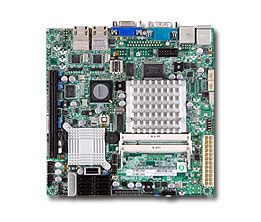
Memory: The D510 platform utilizes DDR2 SODIMMS (commonly used as laptop memory) and the D525 platform utilizes DDR3 SODIMMS. I am recommending 4GB (2x 2GB modules) in either case simply because there are many applications which use more than 2GB of memory, and RAM is cheap.
Enclosure: Ideally I would (LOVE to have a Chenbro ES34069 chassis with six hot swap bays (if it had to be slightly larger so be it). I would recommend getting the 180w version just because four drives at startup plus a future PSU and fans may be taxing on a 120w system. If one was doing a FreeBSD based build with the OS on a USB drive, four storage drives in RAID-Z, RAID-Z2, or RAID 10, and two low-cost SSDs for L2ARC, then this would be a great six drive enclosure. I built a system around one of these and I have been envious enough to want to build one myself. If looking at a 2-4 drive system, this is an ideal case.
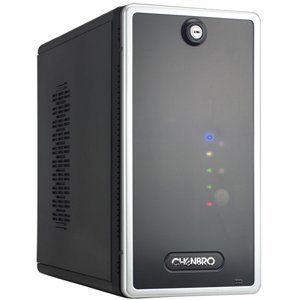
A note here is that it was a very close call going Atom versus a Core i3-530 or i3-540 based system with a Supermicro X8SIL-F. The Atom does shine in light workloads because the idle power consumption to max power consumption delta is very low on Atom chips while it can be much higher on the Core i3 chips. One major downside was the lack of an upgrade path, but a lot of people like these boards even after they retire them from active NAS service because they make good pfsense appliances.
Platform 2
I really wanted to feature an AMD system in one of these builds. AMD does make a decent platform for users that want budget servers without a lot of extra features.
CPU: The AMD Athlon II X4 640 is one of my favorite picks. It is generally found for under $100, uses only a bit more idle power than the dual core variants, and has a lot of horsepower. After reviewing the Athlon II X2 260, Athlon II X3 445, and Athlon II X4 640, I continue to like the quad core model on a somewhat daily basis.
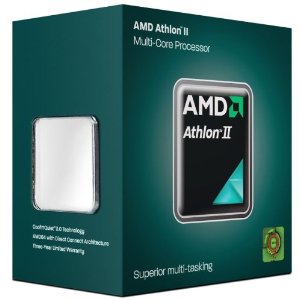
Motherboard: The ASUS M4A88T-M LE is a fairly good AMD 880G chipset motherboard with six onboard SATA ports, onboard HD video, and most importantly, supporting ECC memory. It is relatively cheap, has room to add one PCI and two PCIe NICs, and another open PCIe slot.
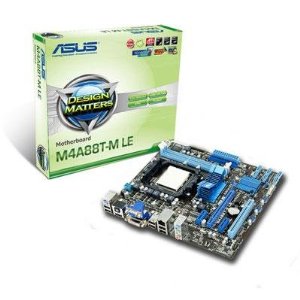
Memory: Again, I am recommending the Kingston KVR1333D3E9SK2/4G 4GB ECC Unbuffered DIMM kit. I have used approximately 100 sticks of this memory and it just works. For this build, I am not going above 4GB just because of the low-end nature of the system. It should be noted that I have seen Microsoft Windows Home Server consume upwards of 2.5GB of RAM so I do think that the days of 2GB being a great point for a server are limited.
NIC: An Intel Gigabit CT Desktop Adapter (or a similar Intel adapter) is basically a requirement for this build. They are fairly cheap and solid PCIe x1 NICs that are supported by many OSes.
Enclosure: Here I was intending to pick a cheap case with 6+ 3.5″ drives where there are lots of options <$50-60. Instead, I am going to splurge a bit and recommend a LIAN LI PC-V354B case (the V354 also comes in red and white) which is a mITX/ mATX case with seven internal 3.5″ drive bays. At around $150, it costs $100 more than other solutions, but the hard drive swapping system is fairly nice, and the build quality is far superior to most $50 generic cases.
Power Supply: Please disregard calls for 600w power supplies in <8 drive systems. Odds are a system like this will spend the vast majority of time pulling well under 100w. The SeaSonic SS-350ET is a 350 watt unit that is 80 PLUS Bronze certified. Bonus points for this power supply because it is from a premium power supply brand (and not some generic unknown) and is fairly quiet.
Price Comparison
Platform 1 (Atom-Supermicro-mITX)
- Motherboard/ CPU: Supermicro X7SPA-HF-D510: $205
- Memory: Crucial CT2CP25664AC667 2x 2GB SODIMMs: $65 (there is a lot of flexibility here)
- Chassis/ Power Supply: Chenbro ES34069 with 180w Power Supply: $200
Approximate total cost: $470
Platform 2 (AMD-mATX)
- CPU: AMD Athlon II X4 640 Propus: $100
- Motherboard: ASUS M4A88T-M LE mATX motherboard: $95
- Memory: Kingston KVR1333D3E9SK2/4G 2x 2GB ECC UDIMM kit: $55
- Additional NIC: Intel Gigabit CT Desktop Adapter: $35
- Chassis: LIAN LI PC-V354B: $150
- Power Supply: SeaSonic SS-350ET: $50
Approximate total cost: $485
Conclusion
Generally, I would say spend a bit more on a system, build once, and do not build multiple times. That philosophy often leads me away from the low-cost segment. With that being said, there are a lot of users that are more than satisfied with what low-end Atom and AMD based NAS systems can do. The Atom build above has IPMI 2.0, very low power consumption, hot-swap bays, and dual Intel NICs onboard. Far faster, the AMD system features a much faster CPU capable of doing most Vail Silverlight transcoding, and a nice case and power supply. Price wise the two systems above come in at under $500 which is much less than the other builds. Of course, both builds can be customized based on an individual’s preferences and requirements.

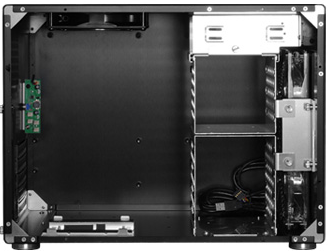



Dell T110 – 1G ram, G1101 2c/2t ( $299 )
Dell T110 – 2G ram, X3430 4c/4t ( $399 )
Dell T110 – 2G ram, X3440 4c/8t ( $489 )
there’s space for four 3.5″ sata drives – six if you repurpose the 5.25 bays and ditch the cdrom. I believe the machine has six 3gbps sata ports, but you could always install a SASUC8I…
I wouldn’t install six ST31500341AS ( ~200 watts ), but six ST32000542AS ( ~140 watts ) should be ok. WD does not specify the spin-up power, but it should be similar to Seagate.
All great Dell systems (not really the focus of the DIY guide). In all of the above you lose 2GB of RAM ($79 upgrade) and probably want a second NIC. The one odd thing about the Dell T110’s is that they are a proprietary format in that you actually open the case from the right side to access the motherboard. Somewhat like Supermicro’s UIO for some expansion cards, Dell’s T110 has a motherboard and case with the components on the opposite side of normal. If one really likes Dell components, this is great. If not, you get stuck. The onboard Nuvotion BMC is the one Supermicro uses (but the Dell version does not have KVM-over-IP). Also, there are only five internal SATA headers on the T110. Still, it is a relatively low cost solution.
Wow. Even your low-end system is too high-end-priced for me (and I bet most users). You at about $500 before even putting drives into it! You could easily trim $150 off of that without compromising much.
Consider:
Inexpensive mATX motherboard: ~$70 (like: MSI 740GM-P25)
– five SATA ports, plus single PATA channel (for OS drive and CDROM)
– imbedded gigabit network interface
– imbedded graphics
– AM3 socket
– available PCI and PCIe slots for expansion options
Low-end AMD CPU: ~$75 (Athlon II X2 265 is more than adequate)
8GB of DDR3 RAM (2 x 4GB): ~$90 (like: G.SKILL Sniper 8GB DDR3)
– Why 8GB? Because you can never have too much RAM. :)
– Also because if you plan to use ZFS you want more RAM than 4GB
Cheap Case: ~$40 (like: ENERMAX Staray ECA3170-BL)
– Why cheap? Because it’s just a box to hold the parts together, you’re not in an enterprise environment, you won’t be swapping hard drives in and out of the thing in an “emergency” where time is of the essence. Your kids can wait long enough for you to turn a screwdriver so they can stream their music.
– Make sure it has enough room for all your drives
– Make sure it has decent ventilation for your drives, if they get hot they will die sooner.
– Make sure it has room for a standard size power supply, not the mini supplies some tiny cases offer.
– Don’t bother with cases that provide their own power supplies, in this low-end price point those power supplies are 90% junk
Decent Power Supply: ~$50 (I agree with the SeaSonic PSU above)
– Don’t cheapen out on the PSU, it could kill your whole system
– When in doubt stick to the big names, like Antec, Enermax, SeaSonic, Zippy
Optical drive: ~$25 DVD-ROM
– you need to install your OS
– you might need to back up some stuff to DVD-R on occasion, so it’s worth the $25
Drives:
Samsung Spinpoint F4 2TB drives: ~$100 each (2TB each)
– stay away from Western Digital “Green” drives (WD20EARS). They have a lot of compatibility issues with RAID configs and controllers.
========================
So, for $350 plus drives, you’ve got a NAS system. Add FreeNAS operating system and five 2TB drives, and you can configure a 8TB ZFS RAID-Z setup for about $850.
If you need to expand to more storage, then add a PCIe x1 SATA controller card (~$30) and two more drives. If you _REALLY_ need to expand, add a PCIe x8 SATA controller (~$45) and add four more drives. Heck, with this setup you could do both, plus a second PCIe x1 SATA controller for a total of 13 drives!
Don’t forget that you can put your operating system on a USB stick and save more room for your storage drives. :)
From what i can see the ASUS M4A88T-M LE only have 2 RAM slots. so the statement “using a 2x 2GB kit allows for another two sticks to be added if people want” isn’t quite right. Is this only a theoretical build or did someone actually try it?
Joe, good catch. It was based off of a few builds done in 2010, however, I actually wrote this article on a long plane ride and despite bringing pictures with me, I made a typo. Fixed the above. Thanks for the heads-up.